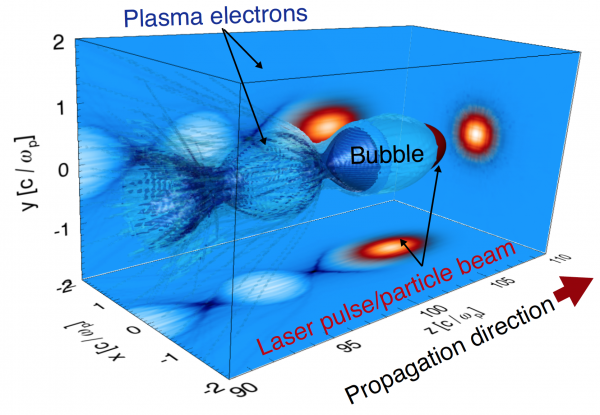Difference between revisions of "RF Superconductivity"
YichaoJing (Talk | contribs) (Created page with "== '''RF Superconductivity for Accelerators in a Course '''== center''3D electron density profile shown being together with the p...") |
(No difference)
|
Revision as of 14:29, 7 November 2022
RF Superconductivity for Accelerators in a Course
3D electron density profile shown being together with the profile of a beam driver. The driver expels the electrons out of its path and drives a wakefield as shown. The 2D projections on the two orthogonal planes are also displayed.Introduction
A game changing technology for accelerator design and operation is the use of radio frequency superconductivity. It allows much more energy efficient and also much more powerful accelerators to be constructed and utilized. The science and technology of radio frequency (RF) superconductivity involves the application of superconductors to RF devices. The Stony Brook University course PHY 543 (RF Superconductivity for Accelerators) is about the application of RF superconductivity to the acceleration of charged particles (electrons, positrons, protons, ions).
Why is RF Superconductivity important for accelerator design and operation? While superconductors are lossless at DC currents, they incur losses when AC currents are applied. However, the electrical resistivity at RF frequencies is ultra-low. For example, RF resonant cavities made of niobium and cooled down to 2 K have surface resistance of 5-6 orders of magnitude smaller than that of copper. This and other properties are exploited to design and construct high-performance particle accelerators.
Future Outlook
Many existing and future particle accelerators worldwide use or plan to use SRF technology.
Examples in the USA: RHIC and EIC at BNL, CEBAF at Jefferson Lab, SNS at ORNL, CESR at Cornell University, PIP-II at Fermilab, ATLAS and ANL, LCLS-II/LCLS-II-HE at SLAC.
Examples worldwide: LHC, FCC-ee, and FCC-hh at CERN, E-XFEL at DESY (Germany), SuperKEKB at KEK (Japan), SPIRAL-2 in France, ESS in Sweden, several project in China and India.
In addition to the applications of the SRF science in particle accelerators, the SRF technology is gaining more and more popularity in the rapidly evolving field of quantum computing. The SRF cavities can be used as superconducting qubits for scalable quantum information processing.
The field of RF superconductivity is very active. The SRF technology is the technology of choice for many types of modern particle accelerators. However, there are still many problems that need attention and careful investigation. This will require better understanding of fundamentals and new technological advances. As accelerator application demands continue to increase (higher energy, higher luminosity, brighter beams, more efficient accelerators, …) there will be no shortage of new challenges to tackle in the future.
The Course
Students will learn the physics underlying RF superconductivity and its application to accelerators, as well as the advantages and limitations of the SRF technology. The aim is to provide students with ideas and approaches that enable them to evaluate and solve problems related to the application of superconducting cavities to accelerators and actively participate in the development of SRF systems for various accelerators. This course includes lectures and review sessions. Homework problems are assigned and graded. The solutions are discussed during the review sessions. There is a final exam at the conclusion of the course.
There are no dedicated courses like this at other universities. Courses on this topic are taught at the U.S. Particle Accelerator School (USPAS), where a two-week course is offered every 2 to 3 years.
Can students work in this area once they graduate? Yes, the field is expanding and there are many new job openings.
The Instructors
Sergey Belomestnykh is an Adjunct Professor of in the Department of Physics and Astronomy at Stony Brook University and Associate Division Head for SRF at Fermi National Accelerator Laboratory (Fermilab). Dr. Belomestnykh has been involved in developing SRF systems for most of his career at Cornell University, BNL, and Fermilab. He is a Fellow of the American Physical Society and a recipient of the 2015 IEEE NPSS Particle Accelerator Science and Technology Award “for achievements in the science and technology of RF and SRF for particle accelerators.”
Irina Petrushina is a Research Assistant Professor of Physics at Stony Brook University. Dr. Petrushina is the winner of the 2020 RHIC and AGS thesis award, and a finalist of the 2021 Blavatnik Regional Award for Young Scientists. Her research is focused on the development of Superconducting Radiofrequency electron photoinjectors, aspects of Coherent electron Cooling, and implementation of diagnostic techniques for laser wakefield accelerators.
The course also includes some specialty lectures that are given by the leading experts in the field. For example, in 2021 an invited lecture on Cryogenics was given by A. Klebaner from Fermi National Accelerator Laboratory.
The course has been offered several times. The last time was during Spring semester of 2021. There were 9 students enrolled in the course. This course falls within the scope of the Ernest Courant Traineeship in Accelerator Science & Engineering and allows for the students outside Stony Brook University to enroll for credit.
